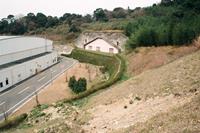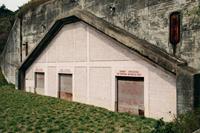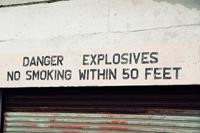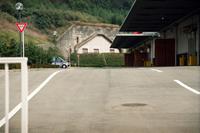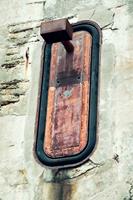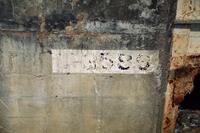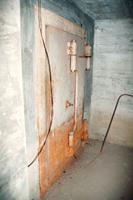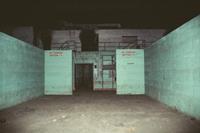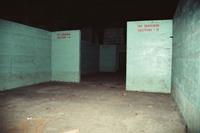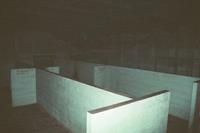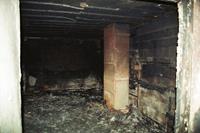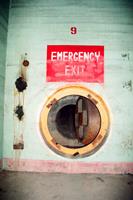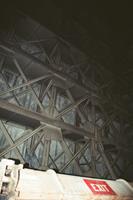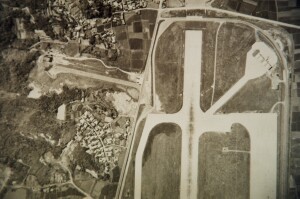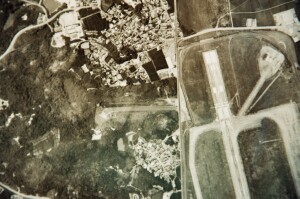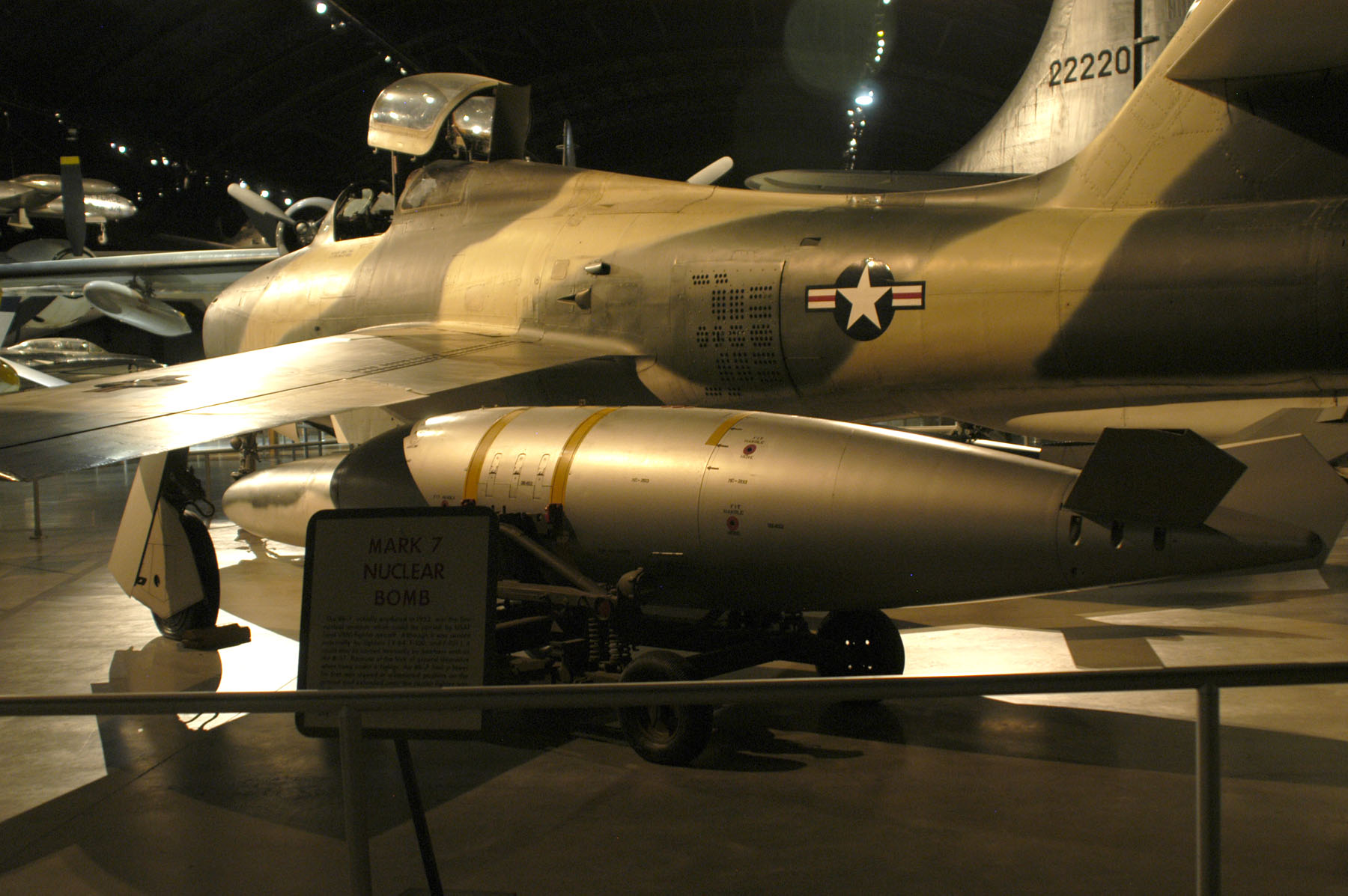Itazuke Air Base ZEL Bunker
ゼロ距離射出F-100戦闘機・板付弾薬庫
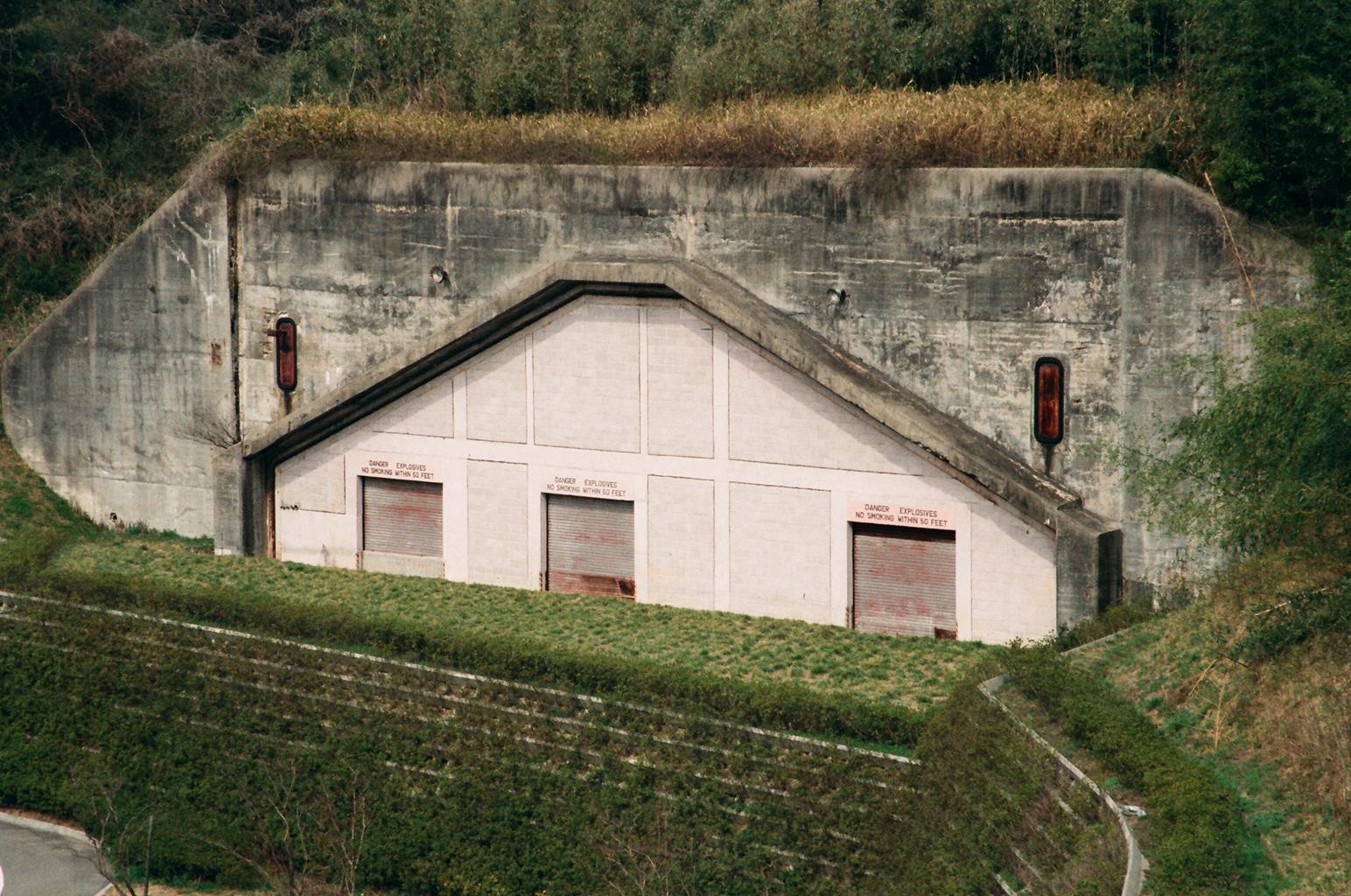
There are a number of installations, relics of the U.S. base years, that still remain in Fukuoka, Japan. Some are hardly recognizable, others very much so. One of the more prominent ones is the alert bunker at the southeast end of Fukuoka International Airport.
This heavily protected underground bunker was constructed during the Cold War in 1956. The initial purpose was to house a fighter jet (F-100) capable of fast take-off on a zero-length launcher (ZEL) with a jet-assisted take-off pack (JATO), for use in the event of a nuclear attack on Japan, basically as a retaliatory/deterrent measure. Fortunately, there was never a need for this action. There were, however, a number of situations in which USAF jets were scrambled to counter Soviet incursions into Japanese airspace along Kyushu.
Here is an assortment of photos of the jets, and there are also a number of YouTube videos showing practice take-offs using a ZEL and JATO pack:
https://www.youtube.com/watch?v=voixUMWvkV4
https://www.youtube.com/watch?v=wDstVGAmI74
https://www.youtube.com/watch?v=IaD8pPMhIAw
https://www.youtube.com/watch?v=wDstVGAmI74
https://www.youtube.com/watch?v=IaD8pPMhIAw
Per RH (1956-1959):
There was an ordinance storage up
on the hill, just east of the base, where
all kinds -- and I mean it -- were stored. The cave was supposed to hold one F-100D on a ZEL (zero length launcher) and launch from the cave. The last batch of F-100D had the capability, but it was never used. I used to use the cave as a classroom to practice loading Nuc weapon shapes, and to teach the pilots from all over the Far East. I ran the school, that is why I was sent there.
----------
The cave with the big concrete door was just finished as I got there in Aug 56. Nothing was ever stored there. Mostly a classroom and a practice loading area for our Nuc loading crews. That was supposedly a "deep secret," but when one ordered an F-100 from the Kyushu model shop, they had the exact dimensions of the SECRET BOMB and they even wanted to know if you wanted a brown nose or black nose (radome on the bomb).
We only used the cave for training. The door was massive and would take 10 min. or so to go up or down. Also it had its own power generator. The picture sure brings back memories.
The ammo dump was E of the S base up in the hills, never the cave that you pictured. The ammo dump was as, I remember, east of the north end of the runway and up a hill and maybe even behind the hill. They stored all kinds of ordinance there. The cave never was considered a "secure" facility, but the ammo dump was.
Since "Nuc weapons" were never allowed in Japan, they used the literal definition to let the "gutless" weapon to be stored. The Mk-7 needed to have a nuclear core to become a weapon, and thus the weapons minus the cores were there in the ammo dump. If there was ever a conflict, we would have loaded the coreless "weapons" and flown to another location to insert the core and go off to do our thing. This has never to my knowledge been disclosed, but the Japanese used to take pictures of us loading the weapons. That is when they found out that there were brown- and black-nosed radomes on the weapons and why the model shop would ask us which one we wanted. It also had a three-fin tail assembly, and one could be retracted for take-off for ground clearance. The model shop also asked if we wanted the fin up or down. Secrets... bah humbug. It was too hard to hide anything.
The Mk-7 weighed 1750 lbs., was 30.5" in diameter, and 182" long. This weapon detail is all public knowledge now in a book that was published a few years ago. This used to be so secret and now you find it in many books!
all kinds -- and I mean it -- were stored. The cave was supposed to hold one F-100D on a ZEL (zero length launcher) and launch from the cave. The last batch of F-100D had the capability, but it was never used. I used to use the cave as a classroom to practice loading Nuc weapon shapes, and to teach the pilots from all over the Far East. I ran the school, that is why I was sent there.
----------
The cave with the big concrete door was just finished as I got there in Aug 56. Nothing was ever stored there. Mostly a classroom and a practice loading area for our Nuc loading crews. That was supposedly a "deep secret," but when one ordered an F-100 from the Kyushu model shop, they had the exact dimensions of the SECRET BOMB and they even wanted to know if you wanted a brown nose or black nose (radome on the bomb).
We only used the cave for training. The door was massive and would take 10 min. or so to go up or down. Also it had its own power generator. The picture sure brings back memories.
The ammo dump was E of the S base up in the hills, never the cave that you pictured. The ammo dump was as, I remember, east of the north end of the runway and up a hill and maybe even behind the hill. They stored all kinds of ordinance there. The cave never was considered a "secure" facility, but the ammo dump was.
Since "Nuc weapons" were never allowed in Japan, they used the literal definition to let the "gutless" weapon to be stored. The Mk-7 needed to have a nuclear core to become a weapon, and thus the weapons minus the cores were there in the ammo dump. If there was ever a conflict, we would have loaded the coreless "weapons" and flown to another location to insert the core and go off to do our thing. This has never to my knowledge been disclosed, but the Japanese used to take pictures of us loading the weapons. That is when they found out that there were brown- and black-nosed radomes on the weapons and why the model shop would ask us which one we wanted. It also had a three-fin tail assembly, and one could be retracted for take-off for ground clearance. The model shop also asked if we wanted the fin up or down. Secrets... bah humbug. It was too hard to hide anything.
The Mk-7 weighed 1750 lbs., was 30.5" in diameter, and 182" long. This weapon detail is all public knowledge now in a book that was published a few years ago. This used to be so secret and now you find it in many books!
Per GP (1965?):
This is the underground hangar.
There used to be a taxiway up to the front. It could hold three F-100's on
alert. There was a steel door that opened downward. When the door was
closed the facility was airtight. When it became obsolete the bricked
up the front and used is as the missile shop. Ext to the hangar was the
bore site range, used for aiming the guns on aircraft. The building to
the right is the "Fukuoka Food Bureau."
----------
TOF is Theater Operational Facility, a dubious term for munitions storage area. The munitions storage area where the tennis courts are was a small bomb dump used to support daily operations of the fighter wing. A few above ground magazines for ammunition, rockets, missiles and a few bombs. The big storage area for support of longer operations was at Yamada, which could support Itazuke, Gannosu, Ashiya, and Tsuiki.
During the Korean War, Itazuke was AF Headquarters for all air operations. It was the only place where a pilot could eat breakfast with his family, fly a combat mission, and return (hopefully) for dinner. There was a US Army anti-aircraft unit on top of the hill in the lower bomb dump during the Korean war. The view of the air field and Fukuoka was great from there.
I don't know of any wells, or vent shafts, but I do know that the area had many old coal mines and test shafts. In the bomb dump there were several test shafts and a red brick tank about 25 feet in diameter by 8 feet tall. There was also another area where medicine bottles were strewn around. I was told that before the war, there was a tuberculosis sanitarium located here.
----------
TOF is Theater Operational Facility, a dubious term for munitions storage area. The munitions storage area where the tennis courts are was a small bomb dump used to support daily operations of the fighter wing. A few above ground magazines for ammunition, rockets, missiles and a few bombs. The big storage area for support of longer operations was at Yamada, which could support Itazuke, Gannosu, Ashiya, and Tsuiki.
During the Korean War, Itazuke was AF Headquarters for all air operations. It was the only place where a pilot could eat breakfast with his family, fly a combat mission, and return (hopefully) for dinner. There was a US Army anti-aircraft unit on top of the hill in the lower bomb dump during the Korean war. The view of the air field and Fukuoka was great from there.
I don't know of any wells, or vent shafts, but I do know that the area had many old coal mines and test shafts. In the bomb dump there were several test shafts and a red brick tank about 25 feet in diameter by 8 feet tall. There was also another area where medicine bottles were strewn around. I was told that before the war, there was a tuberculosis sanitarium located here.
Per GL (1959-1961):
It was located directly across
the highway from the lower end of the runway, at the other end of the
runway from the 68th FIS area where the 86-Ds and later the 102s were
parked and maintained. You can see the gate leaving the base and the
hidden hangar was a little to the left of that gate outside the base.
It was indeed the missile shop for maintenance and storage of the
armament for the F-102s. I was in that shop as a missile tech. Actually
helped set it up in 1959.
Located just to the right of the hangar area was the boresight range where that guns on the F-100s were aligned with the optical sights. The F-100s would be towed out of a gate across the road to the range where they would actually fire tracer ammo to check the guns alignment.
We used to tow the missiles from the underground hangar, up the taxiway past the airport and the civilian air terminal to the 68th area. Took about 15 to 20 minutes one way because we had to get the route cleared of all traffic because we were moving explosives.
-----
The underground hangar was re-opened in 1959 when the 68th FIS received the F-102 Aircraft. That aircraft carried six Falcon guided missiles. The maintenance and storage facility for the missiles was moved into that hangar.
The original door was removed and the photo showing the hangar today shows the front as a concrete wall with steel roll-up doors for access to the area where the missiles were stored. Inside the hangar at the very back was the maintenance facility for the missiles.
I got to Itazuke in the summer of '59 and was one of the missile maintenance airmen assigned to the 68th FIS. I worked in that structure from 1959 to the summer of 1961. In my off-duty time, I also worked at the Base swimming pool at the Annex as a lifeguard and Red Cross swiming instructor.
When the 68th FIS took over the underground hangar, it became a secured area with armed JASDF guards responsible for security of the area and required a special security badge to access the area.
Located just to the right of the hangar area was the boresight range where that guns on the F-100s were aligned with the optical sights. The F-100s would be towed out of a gate across the road to the range where they would actually fire tracer ammo to check the guns alignment.
We used to tow the missiles from the underground hangar, up the taxiway past the airport and the civilian air terminal to the 68th area. Took about 15 to 20 minutes one way because we had to get the route cleared of all traffic because we were moving explosives.
-----
The underground hangar was re-opened in 1959 when the 68th FIS received the F-102 Aircraft. That aircraft carried six Falcon guided missiles. The maintenance and storage facility for the missiles was moved into that hangar.
The original door was removed and the photo showing the hangar today shows the front as a concrete wall with steel roll-up doors for access to the area where the missiles were stored. Inside the hangar at the very back was the maintenance facility for the missiles.
I got to Itazuke in the summer of '59 and was one of the missile maintenance airmen assigned to the 68th FIS. I worked in that structure from 1959 to the summer of 1961. In my off-duty time, I also worked at the Base swimming pool at the Annex as a lifeguard and Red Cross swiming instructor.
When the 68th FIS took over the underground hangar, it became a secured area with armed JASDF guards responsible for security of the area and required a special security badge to access the area.
Per RW:
The
F-100 was the first
supersonic jet fighter to carry nuclear weapons. The first
fighter to carry them was the F-84E and G model. I think what I said
was that the 80th Fighter Bomber Squadron, 8th Fighter Bomber Wing,
Itazuke AB was the first unit to have nuclear weapons on fighters and
we started with the F-84E. The 80th had just transitioned to the
F-100D when I got to Itazuke in December 1957.
I and my friends were the first 2nd Lieutenants to ever be upgraded to Bomb Commander (qualified to drop nuclear weapons). In the 36 months that I was there we lost an A/C every month and a pilot every month and a half. None of this was due to combat. All the losses were training mishaps.
I and my friends were the first 2nd Lieutenants to ever be upgraded to Bomb Commander (qualified to drop nuclear weapons). In the 36 months that I was there we lost an A/C every month and a pilot every month and a half. None of this was due to combat. All the losses were training mishaps.
Per JS (1959-1961):
There have been two mentions of
Itazuke in the last week in our newspapers here -- both deal with the
apparent practice of the US storing nuclear weapons (unassembled) at
Itazuke and Misawa during those years when treaty understandings
prohibited the practice. I can certainly testify that it happened since
I was on one of the loading crews in 1960-61 and would actually arm the
weapons when we took the airplanes to Okinawa and Korea. My sense was
then that it was sort of an "open" secret among the many Japanese
nationals who worked on the base at that time -- which makes me wonder
why it is being presented as some sort of scandal/revelation now in the
the press.
My own observations when I first ventured inside (March 1998; photos below):
I just came from checking out
that bunker that's way at the end of the airstrip. I
took quite a few photos and will get them developed next week. The
three shutter doors are still there with a DANGER sign above each door,
surrounded by concrete that's crumbling from age in a few areas. The
site is up from the main ground level behind a terraced garden at the
back of a large distribution warehouse for the Japanese Govt's
Ministry of Agriculture, Forestry and Fishery. I wonder if they own
that bunker now.
Well, I thought I'd walk up a little closer as no one was around (Saturday). I noticed that the old doors were rusting out and someone apparently had pried open one of the small access doors. I squeezed through and found myself in a mysterious darkness. My eyes got used to the dark after a while and I slowly made my way to the rear, taking pix here and there, listening to my footsteps echo in this huge chamber. Apparently somebody had burned out the upper story offices(?), but whether they brought in wood or used what was inside already is hard to determine. I should have brought a flashlight. The flash photos that I literally took blindly will reveal more later. Gradually I could see more of the amazing lattice work in the reinforced I-beams above me. This ammo bunker was not really under a hillside, but kind of next to a hill, so this ceiling I was looking at had to be built really strong.
The farther back I got away from the front doors and the source of natural light coming thru the cracks, the darker of course it got. I hesitated to go up the stairs to the 2nd floor, but since I came this far, why not go all the way. Slowly ascending, checking each footstep to make sure I wouldn't go thru any rusty spots, I made it to the top and took some more blind shots, then I made my way back down and took a few more shots.
Back outside I noticed the address was still visible: T-3580. And I could make out what looked like a horse figure painted on a rusty plate above the end doors (one on each end). Something must have been written above and below it on the plate, but time had worn that all off. I wonder what the horse symbol meant. Any idea? It may have been another animal. A panther?
So there you have it. I don't know what they'll do with that bunker. I think it should be turned into a museum and house all the memorabilia from the base facilities from 1945 to 1972.
Well, I thought I'd walk up a little closer as no one was around (Saturday). I noticed that the old doors were rusting out and someone apparently had pried open one of the small access doors. I squeezed through and found myself in a mysterious darkness. My eyes got used to the dark after a while and I slowly made my way to the rear, taking pix here and there, listening to my footsteps echo in this huge chamber. Apparently somebody had burned out the upper story offices(?), but whether they brought in wood or used what was inside already is hard to determine. I should have brought a flashlight. The flash photos that I literally took blindly will reveal more later. Gradually I could see more of the amazing lattice work in the reinforced I-beams above me. This ammo bunker was not really under a hillside, but kind of next to a hill, so this ceiling I was looking at had to be built really strong.
The farther back I got away from the front doors and the source of natural light coming thru the cracks, the darker of course it got. I hesitated to go up the stairs to the 2nd floor, but since I came this far, why not go all the way. Slowly ascending, checking each footstep to make sure I wouldn't go thru any rusty spots, I made it to the top and took some more blind shots, then I made my way back down and took a few more shots.
Back outside I noticed the address was still visible: T-3580. And I could make out what looked like a horse figure painted on a rusty plate above the end doors (one on each end). Something must have been written above and below it on the plate, but time had worn that all off. I wonder what the horse symbol meant. Any idea? It may have been another animal. A panther?
So there you have it. I don't know what they'll do with that bunker. I think it should be turned into a museum and house all the memorabilia from the base facilities from 1945 to 1972.
|
18 January 1959 – F-100 /
Itazuke AB, Japan
At about 11:55 AM local time, the 8th Tactical Fighter Wing aircraft was parked on a revetted hardstand in ground alert configuration. The external load consisted of a MK 7 nuclear weapon on the left wing intermediate station, one 275 gallon drop tank on the right wing intermediate station, and one 200 gallon drop tank each on the left and right wing inboard stations. When the aircraft's engine starter button was depressed during a practice alert early in the morning, an explosion and fire occurred when the three external fuel tanks inadvertently jettisoned and the left wing 200 gallon tank ruptured and caught fire; the fire spread to the other two tanks. The weapon was exposed to constant heat and intermittent flames from the burning fuel, resulting in the forward section of the bomb either melting or falling off, exposing fuzing components and the weapon's nickel-cadmium batteries. The lower battery had shorted out. The upper battery was warped and its cables had burned through; however, the battery was still charged. Portions of the center section bottom were melted away, exposing detonators around the warhead sphere. Several of these detonators were cracked and scorched; insulation on several detonator lead cables was softened but intact. Pull-out wires were in place and the arm-safe switch was on "safe." Personnel in the aircraft's revetment and in adjacent revetments were evacuated as quickly as possible. Fire trucks at the scene put out the fire with foam and water in about seven minutes. The nuclear capsule for the bomb was not in the vicinity of the aircraft and was not involved in the accident. Desiccant bags in the aft end of the weapon caught fire and were burned; in addition, the radome at the front end of the bomb burned and a few detonator cables were scorched. The weapon's HE appeared intact upon examination. There were no cleanup or nuclear contamination problems. The damaged weapon was returned to the U.S. for refit and further examination. - from The Swords of Armageddon
by Chuck Hansen, Vol. VII, p.253 |
What started out, then, in 1956 as an reinforced alert hangar for F-100's, ended as an ammo bunker to store weapons for the tactical fighters during their active service until 1964. All US bases in Fukuoka reverted back to Japan in 1972. It would be great to see something done with this remaining facility to help remember the US base and the important role it played during the Cold War.
Photos
from March 1998
(click on images for higher resolution)
(click on images for higher resolution)
